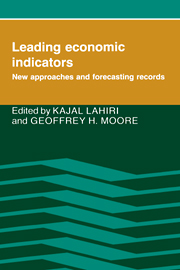Book contents
- Frontmatter
- Contents
- Preface
- List of contributors
- 1 Introduction
- PART I NEW CONCEPTS AND METHODS
- PART II FORECASTING RECORDS AND METHODS OF EVALUATION
- 9 Forecasting cyclical turning points: The record in the past three recessions
- 10 Turning point predictions, errors, and forecasting procedures
- 11 Forecasting peaks and troughs in the business cycle: On the choice and use of appropriate leading indicator series
- 12 Using a consensus of leading economic indicators to find the right ball park for real GNP forecasts
- 13 Some Australian experience with leading economic indicators
- 14 Turning point prediction with the composite leading index: An ex ante analysis
- 15 Forecasting recessions under the Gramm-Rudman-Hollings law
- 16 Leading indicators of inflation
- PART III NEW ECONOMIC INDICATORS
- Index
11 - Forecasting peaks and troughs in the business cycle: On the choice and use of appropriate leading indicator series
Published online by Cambridge University Press: 05 June 2012
- Frontmatter
- Contents
- Preface
- List of contributors
- 1 Introduction
- PART I NEW CONCEPTS AND METHODS
- PART II FORECASTING RECORDS AND METHODS OF EVALUATION
- 9 Forecasting cyclical turning points: The record in the past three recessions
- 10 Turning point predictions, errors, and forecasting procedures
- 11 Forecasting peaks and troughs in the business cycle: On the choice and use of appropriate leading indicator series
- 12 Using a consensus of leading economic indicators to find the right ball park for real GNP forecasts
- 13 Some Australian experience with leading economic indicators
- 14 Turning point prediction with the composite leading index: An ex ante analysis
- 15 Forecasting recessions under the Gramm-Rudman-Hollings law
- 16 Leading indicators of inflation
- PART III NEW ECONOMIC INDICATORS
- Index
Summary
This chapter is the result of attempts to find a way to extract as much information as possible about future economic activity from the twelve time-series commonly referred to as the leading indicators.
Leading indicators are data series that tend to lead business activity. Generally, it is believed that changes in certain economic variables precede, in a causal fashion, other economic variables. Because some of the leading series may produce false signals of future changes, it is also believed that an index composed of several of these leading series, chosen from a variety of economic processes, provides a better indication of future activity than any one series.
The most important of the single series used by business economists to forecast future economic activity is the so-called Index of Leading Indicators. This series is calculated by the Department of Commerce and published in the Survey of Current Business. The monthly announcements of the latest Index figure and the changes in the series composing it are major economic events. This chapter is an attempt both to test the forecasting ability of the Index and to create new indices that are more useful in forecasting peaks and troughs in the business cycle.
Section 11.1 is a review of some of the earlier attempts to use leading indicators to forecast economic activity. In section 11.21 present the theoretical basis for my own research and the results of my attempts to use the indicator series to forecast turning points in the business cycle. Section 11.3 presents my conclusions.
- Type
- Chapter
- Information
- Leading Economic IndicatorsNew Approaches and Forecasting Records, pp. 183 - 196Publisher: Cambridge University PressPrint publication year: 1991
- 1
- Cited by



